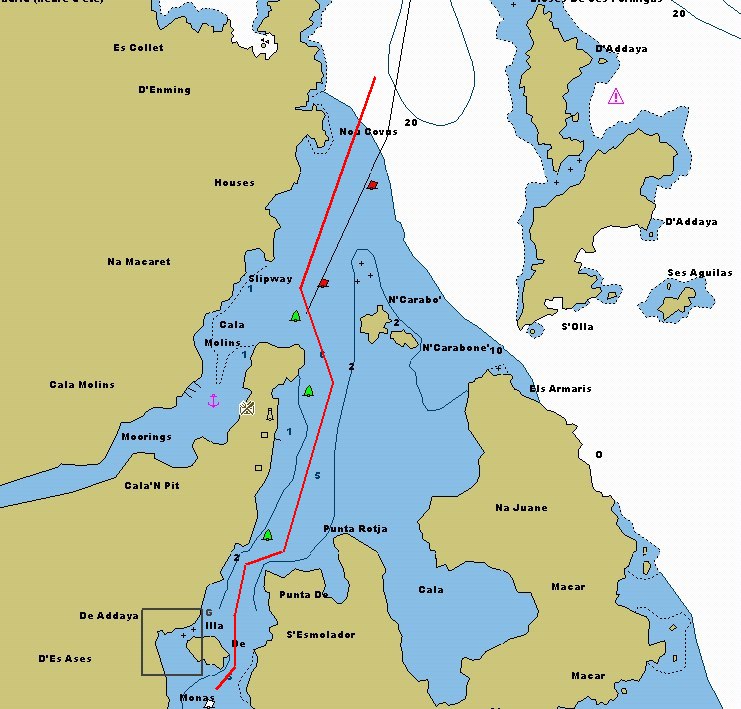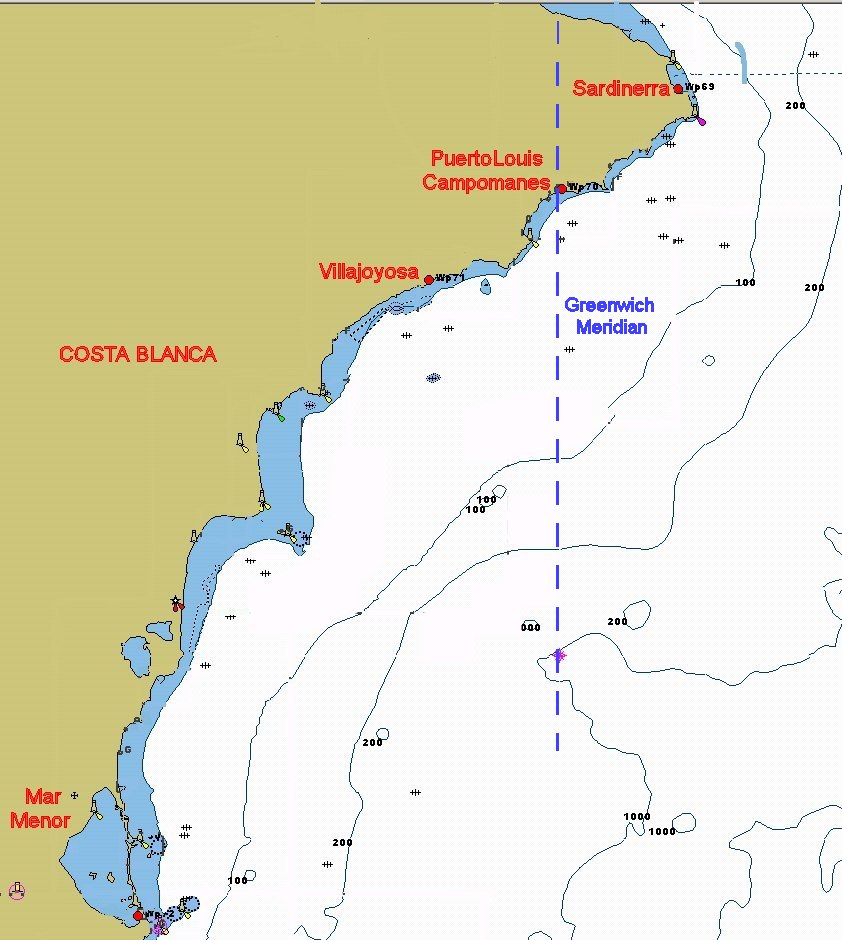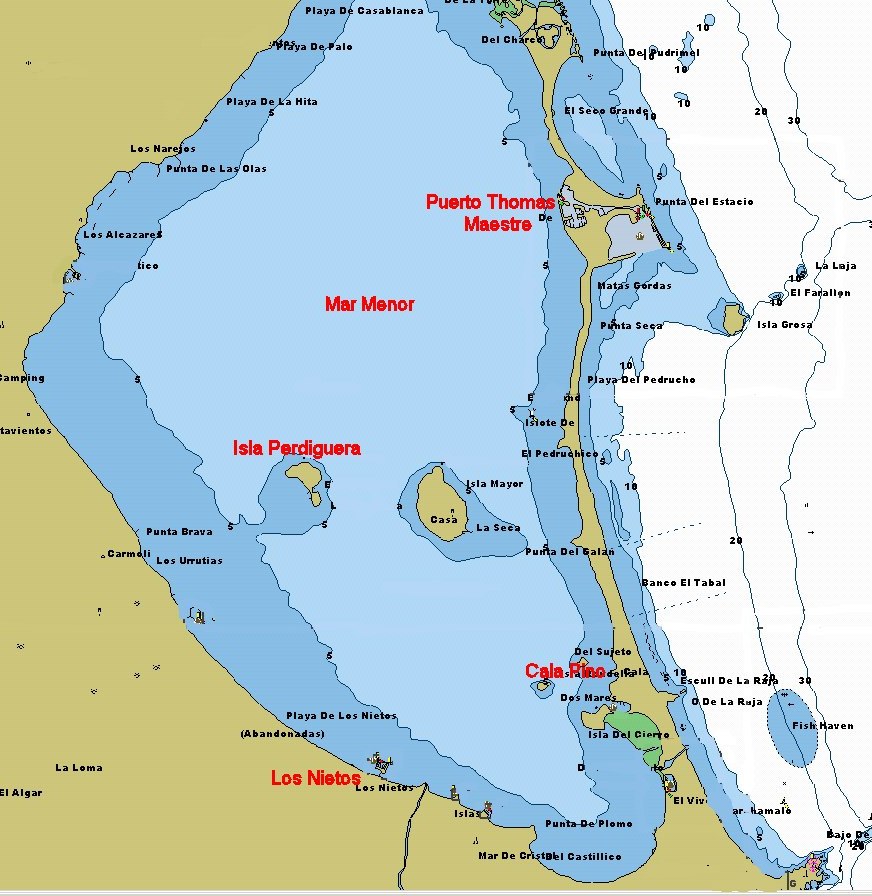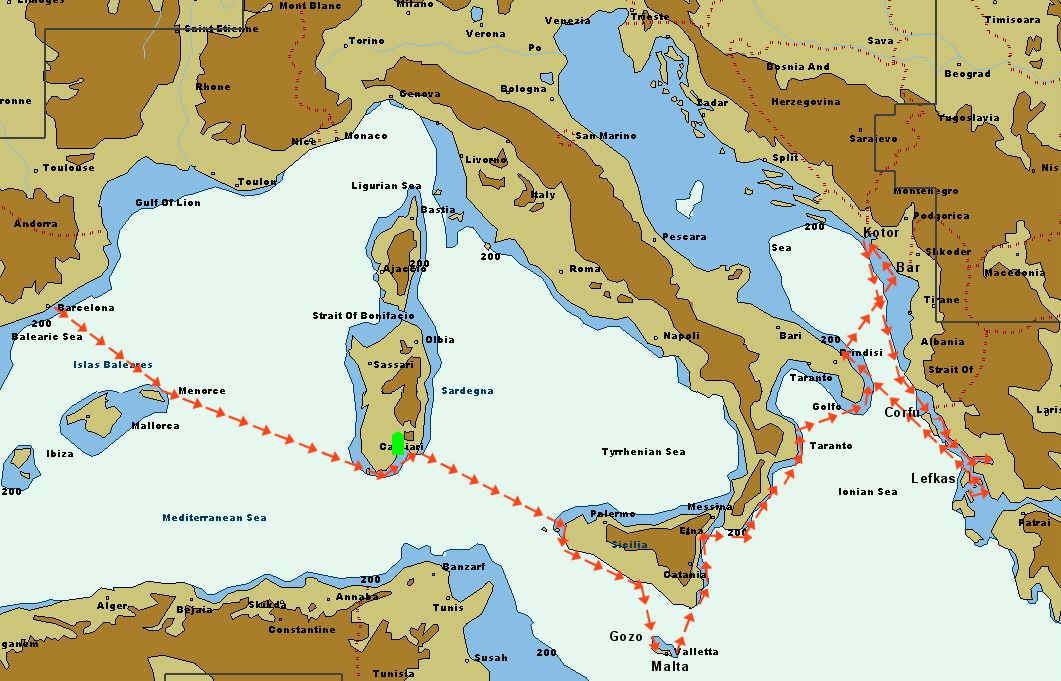Summer 2011
Mallorca
This summer we cruised parts of the Balearic Islands, crossed from Ibiza to the Spanish mainland then south along the Costa Blanca to the inland sea of Mar Menor. Finally back to the Balearics and to Barcelona. We ventured further west than ever before, crossing the Greenwich meridian which was a highlight for me until I realised it runs north-south through Greenwich so many people must cross it every day by bicycle, by car, or on foot without even knowing but it was still an experience for me. We also spent a record 149 contiguous days anchoring without spending a night on a quay. In our perception there were fewer boats around this year than a couple of years ago. The anchorages were quieter even in July and August and there were fewer tourists around. The financial situation is taking it's toll with bars, restaurants, and shops having gone out of business and many of those that remain were practically devoid of customers.
We left Barcelona on the 27th April after topping up with fuel. Adam and Camilla (yacht Isola) were also crossing at the same time but we managed to loose each other while we were at the fuel quay as they were having minor mechanical difficulties. There was an uncomfortable swell during the first several hours but that subsided and the remainder of the journey was uneventful. We arrived in Mallorca and anchored in Pollenca bay at 09:40 next day, Adam and Camilla arrived just a couple of hours later.
After several nights at anchor we decided to go on the public quay at Pollenca on the 5th May because Tan was scheduled to go to Wales on the 7th and we had several things to do in the meantime. The day after Tan left I went back out to the bay and anchored. I had a superb meal on Kathai with John and Dar (she's a great cook) and a couple of nights later Adam and Camilla came over for drinks and a meal. I got a phone call from Adam at 04:30 in the morning telling me my anchor was dragging, how embarrassing – and careless. I raised the anchor and re-anchored under the castle with 70 metres of chain out. Nothing was going to shift me now!
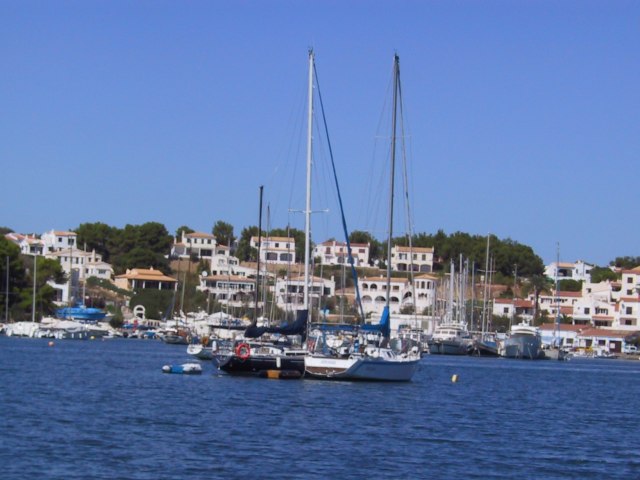 Addaya, Menorca
After that incident I went round to Aucanada and anchored for a couple of nights for a change of scenery. I ran aground when leaving early on the 19th and had a few heart-stopping moments trying to get free which I did with he aid of the bow thruster and going hard astern. Back to Pollenca where I stayed for 21 nights, four of which were on the public quay to collect Tan on her return and to have some work done on the boat. The in-mast furling had been giving problems for quite a while so I had Pete (Moondance) check it and fix it. He is and excellent rigger and soon solved the problem. Money well spent.
Addaya, Menorca
After that incident I went round to Aucanada and anchored for a couple of nights for a change of scenery. I ran aground when leaving early on the 19th and had a few heart-stopping moments trying to get free which I did with he aid of the bow thruster and going hard astern. Back to Pollenca where I stayed for 21 nights, four of which were on the public quay to collect Tan on her return and to have some work done on the boat. The in-mast furling had been giving problems for quite a while so I had Pete (Moondance) check it and fix it. He is and excellent rigger and soon solved the problem. Money well spent.
The last few days of May and the first few days of June were cold with rain and strong winds nevertheless we went to the buffet at Ses Torres with Mike and Chris (Shabonee) for a lunchtime blow-out. It's still as good and cheap as ever. After a few days to recover we made the crossing from Mallorca to Menorca, dropping anchor in Fornells on the north coast, one of our favourite places, where we stayed for nine nights. En-route we were inspected by four dolphins who played in our bow-wave for several minutes. Unfortunately there were jellyfish when we arrived. We bumped into Michael & Teresa (Moondance of Belfast) who invited us to a BBQ at their villa on Saturday night along with their family and other friends. It was a great night. Magically the jellyfish disappeared next day so swimming commenced. We saw several super-yachts around, presumably assembling for the big regatta at Palma in which the king of Spain competes. During our stay here Tan took the bus from Fornells to Es Mercadal for sightseeing and to check out the shops and thought it was a very pleasant village.
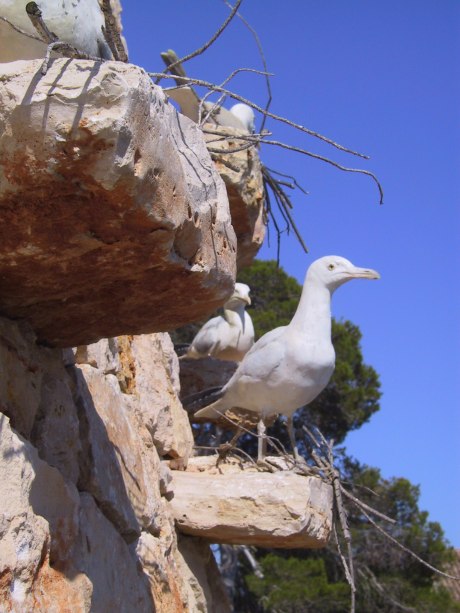 Sculptures at the Cabrera visitor centre
On the 16th June we had a leisurely start and sailed the seven miles to the very picturesque harbour at Addaya dropping anchor just after 13:00 hours after negotiating the
Sculptures at the Cabrera visitor centre
On the 16th June we had a leisurely start and sailed the seven miles to the very picturesque harbour at Addaya dropping anchor just after 13:00 hours after negotiating the
![]() very tricky entrance to the cala . There are even more private buoys than last time we were here in 2004 but we managed to find a place to anchor. It was a very hot day and we were surprised to see cows foraging (not enough grass to graze) along the edge of the cala at dusk and it was lovely to hear bird song and see the ducks. Two days later we went to Es Grau on the east coast to anchor but there are so many buoys by the village we had to anchor behind the island Isla Colom. On the 2nd day I retrieved a dinghy that had come loose from a German registered yacht and was rapidly being blown out to sea. When I returned it they were quite shocked and so was I later, when they came over and presented me with a bottle of wine with 100 euros wrapped round the neck which I tried to refuse but they were very insistent.
very tricky entrance to the cala . There are even more private buoys than last time we were here in 2004 but we managed to find a place to anchor. It was a very hot day and we were surprised to see cows foraging (not enough grass to graze) along the edge of the cala at dusk and it was lovely to hear bird song and see the ducks. Two days later we went to Es Grau on the east coast to anchor but there are so many buoys by the village we had to anchor behind the island Isla Colom. On the 2nd day I retrieved a dinghy that had come loose from a German registered yacht and was rapidly being blown out to sea. When I returned it they were quite shocked and so was I later, when they came over and presented me with a bottle of wine with 100 euros wrapped round the neck which I tried to refuse but they were very insistent.
A very early start (05:30) on the 16th on passage to Mallorca. Due to the winds easterly component many of the anchorages on the east coast of Mallorca would be uncomfortable so we opted for a direct run to Porto Colom, the safest haven on that coast. It was slow going against a SE swell until noon, then once clear of Menorca we picked up the leading edge of a Mistral out of the Gulf de Lion and roared across the Menorca Canal at over 8 knots with the sails reefed in a force 6, anchoring at our destination by 17:35. Porto Colom cannot be called pretty but it is safe and practical. Being a working town it has a wide variety of shops and while we were there the long-line fishing fleet came in and unloaded some very large swordfish under the watchful eye of the authorities. Our intention was to navigate clockwise along the east and southern coasts of Mallorca until we arrived at a convenient launching point for Ibiza.
Just seven miles south is Porto Petro so that's where we headed on the 22nd for what should have been a leisurely jaunt, however the sea was unexpectedly choppy and chaotic. Porto Petro is pretty, much smaller than Colom and almost circular in shape. A swell worked it's way into the "cauldron" and caused us to yaw so the night was uncomfortable. In a bid to find a more comfortable anchorage next day, we rounded the SE tip of Mallorca and anchored in Cala Cargols. A wide bay as yet unspoiled by tourist development, with long sandy beaches backed by trees. It is open to the south but well protected from the dreaded E and NE swell. Some five miles offshore the Cabrerra Islands nature reserve rise majestically out of the sea providing an impressive backdrop and if that wasn't enough the unspoiled beaches were dotted with topless and nude sunbathers! But alas all this may soon change, one house has already been built and the area is zoned for residential development.
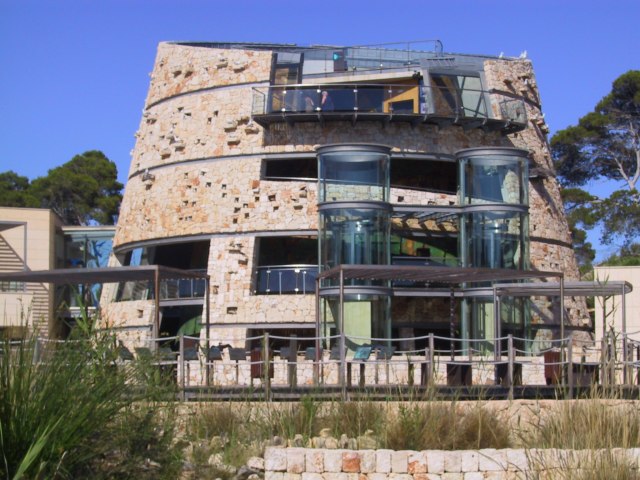 Cabrerra Reserve Visitors Centre.
After two nights we reluctantly moved on because the forecast was for the wind veering to the south. Our next stop was Colonia Sant-Jordi. The town juts out on a rocky peninsular and has three good supermarkets plus a large variety of other shops. We took the dinghy to a tiny island at the entrance of the cala and inhabited only by gulls and small black lizards. Tan even paddled in the shallows! Undoubtedly the highlight of the area is the new Cabrera Nature Reserve Visitors Centre. Above ground the building is conical with a central core around which the history of the Mediterranean is depicted on a mural as you follow the spiral walkway upwards. The outside of the building is uneven stone with nooks and ledges adorned with statues and bronzes of birds and nests. Below ground is an amazing series of huge aquariums displaying the oceanic life of the Mediterranean. And it's free!
Cabrerra Reserve Visitors Centre.
After two nights we reluctantly moved on because the forecast was for the wind veering to the south. Our next stop was Colonia Sant-Jordi. The town juts out on a rocky peninsular and has three good supermarkets plus a large variety of other shops. We took the dinghy to a tiny island at the entrance of the cala and inhabited only by gulls and small black lizards. Tan even paddled in the shallows! Undoubtedly the highlight of the area is the new Cabrera Nature Reserve Visitors Centre. Above ground the building is conical with a central core around which the history of the Mediterranean is depicted on a mural as you follow the spiral walkway upwards. The outside of the building is uneven stone with nooks and ledges adorned with statues and bronzes of birds and nests. Below ground is an amazing series of huge aquariums displaying the oceanic life of the Mediterranean. And it's free!
On the morning of the 28th June we rounded Cabo Blanco and entered the bay of Palma where the US aircraft carrier Enterprise dominated the scene. We anchored in the lee of Arenal marina off a small beach overlooked by two very nice villas, some apartments and a high-rise. This is a good place to provision with big Eroski and Mercadona supermarkets and a laundrette but otherwise the town is tourist tacky with myriads of bars and tattoo parlous jostling for business. Despite, or perhaps because of, the tourist influx, the local people are very pleasant and helpful, maybe we amused them with our primitive Spanish! We provisioned and did two loads of laundry, much to Tan's relief.
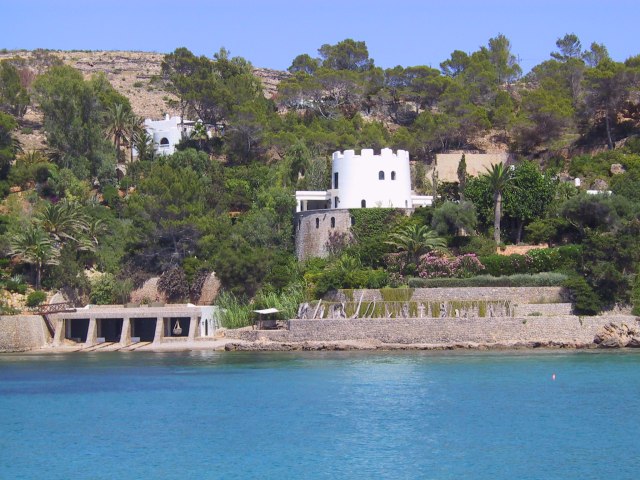 Cala Balnca, Ibiza
We crossed to the west of Palma bay and anchored in the lee of Las Illetas where we met Mo and John who invited us to their boat (Fuga) for drinks. It is still a pleasant anchorage for a stopover in the right wind and sea conditions and hasn't changed since our last visit here. On the 1st July we arrived at Santa Ponsa where we stayed two nights while we got provisions (BIP and Eroski supermarkets) and took on fresh water ready for the crossing to Ibiza.
Cala Balnca, Ibiza
We crossed to the west of Palma bay and anchored in the lee of Las Illetas where we met Mo and John who invited us to their boat (Fuga) for drinks. It is still a pleasant anchorage for a stopover in the right wind and sea conditions and hasn't changed since our last visit here. On the 1st July we arrived at Santa Ponsa where we stayed two nights while we got provisions (BIP and Eroski supermarkets) and took on fresh water ready for the crossing to Ibiza.
Ibiza
We decided to do the 59 mile crossing to Ibiza as an overnight passage, leaving just after nine in the evening. It was an unpleasant journey, we managed to sail for a couple of hours then the wind swung round onto the nose and stayed there until we anchored in Cala Xarraca at 07:30. Then the wind swung 180 degrees creating an uncomfortable swell so we re-anchored a mile away at Cala Portinatx which was a little better. We met a lovely young couple on the beach and invited them back to the boat for drinks. The wind overnight was stronger than forecast and several boats dragged their anchors but we held fast with 35 meters of chain out. There were jellyfish when we arrived but they disappeared overnight so we enjoyed some good swimming. Although the cala is built-up the music is not intrusive and stops at midnight.
We were working our way round the NW coast on the morning of the 6th July when we discovered Cala Blanca just 45 minutes from Portinatx. A squarish cala some 500m wide with crystal clear water over white sand and surrounded by low cliffs. There is a spectacular white round house with crenelated parapet, beautiful gardens and four boat houses occupying one corner. This part of Ibiza was ravaged by forest fires in the spring but this cala survived almost unscathed still supporting lots of greenery. Very tranquil.
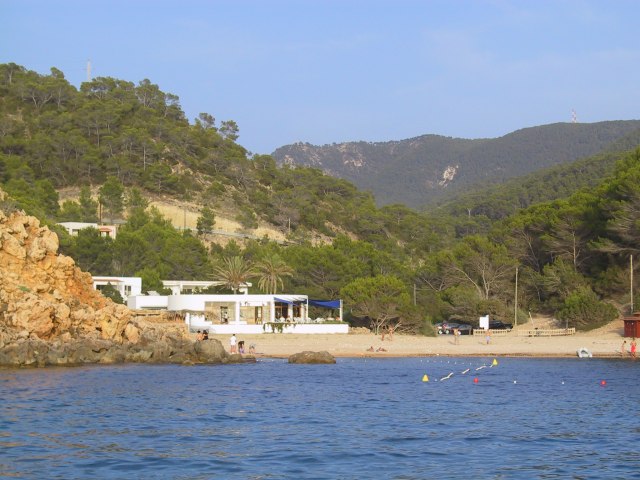 Cala Moli, Ibiza.
We would have stayed longer than two nights but we needed fresh water and produce so we went to San Antonio where I anchored but got complaints from the admiral so re-anchored. We topped up with fuel and duly replenished our stocks then left next day. As we rounded on to the west coast we took the narrow passage over the sill (3 metres) between Isla Conejera and Isla del Bosque which my chart disconcertingly shows as "drying out" but the pilot book says is a passage. We anchored in the very small but pretty Cala Moli. There is a popular beach, a restaurant with swimming pool and a few unobtrusive dwellings on the low cliffs. I went swimming and got stung by a jellyfish on my shoulder but not badly. The 2nd day was a Sunday so we decided to check out the beach restaurant for lunch but at 22 euro per head for a mixed paella it was a definite no-no.
Cala Moli, Ibiza.
We would have stayed longer than two nights but we needed fresh water and produce so we went to San Antonio where I anchored but got complaints from the admiral so re-anchored. We topped up with fuel and duly replenished our stocks then left next day. As we rounded on to the west coast we took the narrow passage over the sill (3 metres) between Isla Conejera and Isla del Bosque which my chart disconcertingly shows as "drying out" but the pilot book says is a passage. We anchored in the very small but pretty Cala Moli. There is a popular beach, a restaurant with swimming pool and a few unobtrusive dwellings on the low cliffs. I went swimming and got stung by a jellyfish on my shoulder but not badly. The 2nd day was a Sunday so we decided to check out the beach restaurant for lunch but at 22 euro per head for a mixed paella it was a definite no-no.
A leisurely start on the morning of the 11th July as we continued our journey southward along the west coast. Cala Vadella is described in the pilot as being very attractive and indeed it is but it is also very narrow and very deep until close-in where all the local mooring buoys are so we decided to continue on. We finally settled at Cala Horts, a wide cala with a long stony beach, three beach restaurants and stunning views of Isoleta Vedra rising steep sided 382m out of the sea like the setting for a fairy tale or medieval drama! It is also an ideal jumping off point for the Costa Blanca on the mainland.
Cost Blanca
We did the 50nm crossing of the Ibiza Canal in just over nine hours but during the last hour the wind swung round to the SE causing us to change our destination from Cala Moraira to Cala Sardinera. Not a pretty cala, it is edged by old mine workings, but there are Posidonia buoys here so we picked one up. In the evening two local boats arrived, rafted together, then played very pleasant guitar music and had a "jam session". Woke at 04:00 because the wind had changed again and the swell was getting up, so a very early start, leaving as soon as it was light at 06:00.
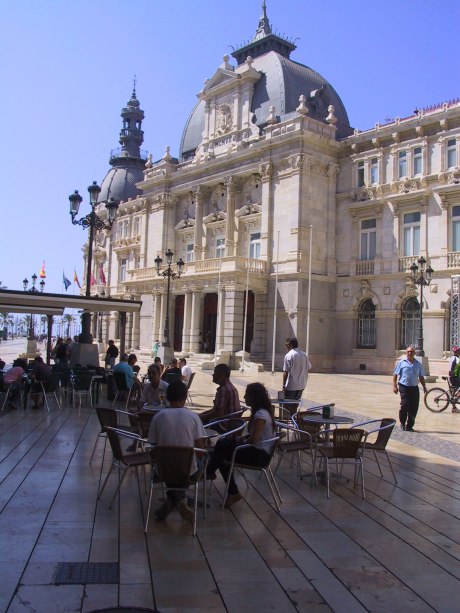 Cartagena city hall.
The plan was to cover the 80nm along the
Cartagena city hall.
The plan was to cover the 80nm along the
![]() Costa Blanca in short hops anchoring where possible overnight. The reality was that a strong on-shore swell made most of the anchorages (which are scare) untenable. We dropped anchor at Luis Campomanes almost on the Greenwich Meridian and went in search of shops – there aren't any, but we managed to buy bread at the café where we had lunch. The swell was worse when we gat back to the boat at 14:30 so we decided to continue along the coast, finally anchoring behind the marina at Villajoyosa at 17:50. There was better protection here but I used a stern anchor to hold us into swell which significantly reduced the yawing and improved the comfort level.
Costa Blanca in short hops anchoring where possible overnight. The reality was that a strong on-shore swell made most of the anchorages (which are scare) untenable. We dropped anchor at Luis Campomanes almost on the Greenwich Meridian and went in search of shops – there aren't any, but we managed to buy bread at the café where we had lunch. The swell was worse when we gat back to the boat at 14:30 so we decided to continue along the coast, finally anchoring behind the marina at Villajoyosa at 17:50. There was better protection here but I used a stern anchor to hold us into swell which significantly reduced the yawing and improved the comfort level.
The forecast for the next several days was for easterlies so we decided to go to the Mar Menor in one jump, leaving at 06:48 and arriving twelve hours later. Large stretches of the Costa Blanca coastline is concrete jungle segregated by sheer cliffs where it is impractical to build. One such sheer cliff-face had a waterfall gushing out about half way up! We arrived at the entrance to the Mar Menor and had to wait over an hour for the bridge to open, but finally we were through and anchored at Puerto La Manga at the southern end of the sea.
The
![]() Mar Menor is an extraordinary inland sea covering 13,500 hectare, being 12 miles (19km) long by 6 miles (9.6km) wide and separated from the Mediterranean by a 24km long narrow strip of land, La Manga, from which a line of mini-sky-scrapers rise
Mar Menor is an extraordinary inland sea covering 13,500 hectare, being 12 miles (19km) long by 6 miles (9.6km) wide and separated from the Mediterranean by a 24km long narrow strip of land, La Manga, from which a line of mini-sky-scrapers rise ![]() (see "Mar Menor Ecology"). The area is a magnet for Spanish tourists. The sea is on average 3 to 5 metres deep with five small islands in the southern half. Of the three entrances only one is deep enough for navigation. There are several marina's around the inland coast the largest being at the entrance (Thomas Maestre), the 2nd largest (San Javier) in the NW is a naval air force harbour and part of the air academy thus not open to the public. However, the most noticeable thing about the Mar Menor was the millions of jellyfish (I do not exaggerate) some the size of dinner plates, others more like serving platters. They were so dense you could almost walk across them! Swimming was out of the question. The beaches are protected by long heavy nets with channels for boats but jellyfish still managed to get through. As the summer progressed some were chopped up by propellers into jellyfish stew and clogged the intakes to the flushing toilets – yuk.
(see "Mar Menor Ecology"). The area is a magnet for Spanish tourists. The sea is on average 3 to 5 metres deep with five small islands in the southern half. Of the three entrances only one is deep enough for navigation. There are several marina's around the inland coast the largest being at the entrance (Thomas Maestre), the 2nd largest (San Javier) in the NW is a naval air force harbour and part of the air academy thus not open to the public. However, the most noticeable thing about the Mar Menor was the millions of jellyfish (I do not exaggerate) some the size of dinner plates, others more like serving platters. They were so dense you could almost walk across them! Swimming was out of the question. The beaches are protected by long heavy nets with channels for boats but jellyfish still managed to get through. As the summer progressed some were chopped up by propellers into jellyfish stew and clogged the intakes to the flushing toilets – yuk.
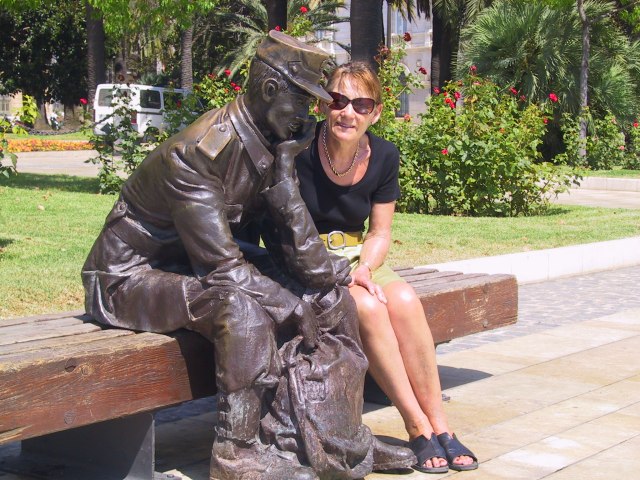 Tan with "friend" in Cartagena.
During the three weeks we were in the Mar Menor we anchored 23 times, often twice a day and never for more than for 2 nights at a time. We often moved because of changes in wind direction or to go to the market, to go to the laundrette, to go shopping, or to get fresh water from Thomas Maestre. Our favourite anchorage was behind the 2nd largest island, Isla Perdigeura, a kidney shaped island inhabited by gulls, breading colonies of egrets, terns, and rabbits. There are also several derelict buildings of two obviously different time periods but I haven't been able to find out about their history. Another nice anchorage was Cala del Pino which as it’s name suggests has lots of mature and very healthy looking pine trees along the top of the beech. The town of Los Nietos on the north coast has three things going for it, a Sunday market with an excellent local wine, a small but very good supermarket, and a single track narrow gauge railway that winds its way through the mountains to Cartagena. We took the train to La Union. It laboured uphill and hurtled downhill, quite an experience. La Union was famous as a rich mining town and still has many magnificent buildings although the mining has long since been abandoned. It is now home to a mining museum and a flamenco museum and hosts an annual flamenco festival in August. We had an excellent lunch at a café in the market square. La Union is also the place where Tan persuaded me to get a haircut – the shortest I've had since puberty!
Tan with "friend" in Cartagena.
During the three weeks we were in the Mar Menor we anchored 23 times, often twice a day and never for more than for 2 nights at a time. We often moved because of changes in wind direction or to go to the market, to go to the laundrette, to go shopping, or to get fresh water from Thomas Maestre. Our favourite anchorage was behind the 2nd largest island, Isla Perdigeura, a kidney shaped island inhabited by gulls, breading colonies of egrets, terns, and rabbits. There are also several derelict buildings of two obviously different time periods but I haven't been able to find out about their history. Another nice anchorage was Cala del Pino which as it’s name suggests has lots of mature and very healthy looking pine trees along the top of the beech. The town of Los Nietos on the north coast has three things going for it, a Sunday market with an excellent local wine, a small but very good supermarket, and a single track narrow gauge railway that winds its way through the mountains to Cartagena. We took the train to La Union. It laboured uphill and hurtled downhill, quite an experience. La Union was famous as a rich mining town and still has many magnificent buildings although the mining has long since been abandoned. It is now home to a mining museum and a flamenco museum and hosts an annual flamenco festival in August. We had an excellent lunch at a café in the market square. La Union is also the place where Tan persuaded me to get a haircut – the shortest I've had since puberty!
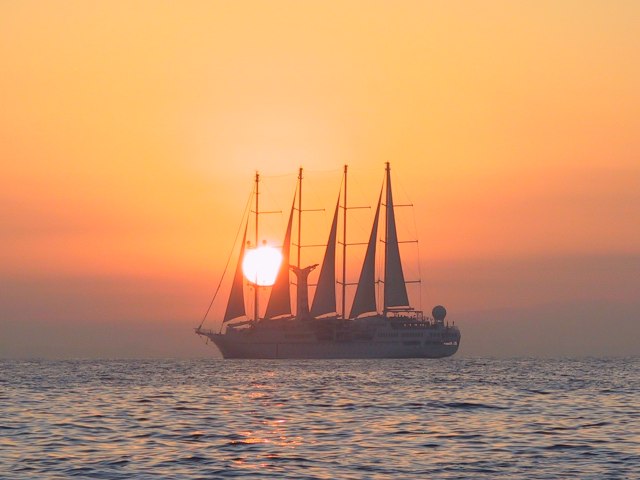 Club Med entering Palma at sunrise.
Other highlights of our stay in Mar Menor were seeing a "Red Arrows" type formation and some practice parachute jumps near the naval air base. One day a small yacht with four nubile females anchored well ahead of us and sunbathed topless which is very unusual in this region. Later I looked up from reading to discover they had dragged anchor and were nearly on top of us, they were highly embarrassed when I called to them. I rescued yet another wayward dinghy and we also rescued a very pleasant father and young son who had been blown a couple of miles out to sea in a kayak by the increasing wind and towed them back to shore. The little boy was marvellous, handling it all in his stride. We took the bus to Cartagena and had a nice day out. Cartagena is a interesting city with fine buildings, gardens, open spaces and bronzes depicting the history. There is a lot of restoration work in progress. Often the restoration involves saving the original façade by shoring it up and gutting the buildings behind ready for new construction. We also had a very pleasant tour of the magnificent city hall. Unfortunately we missed Pete and Carol (Gallant Girl), Pete now works in a marina there but we got to speak to them by phone later.
Club Med entering Palma at sunrise.
Other highlights of our stay in Mar Menor were seeing a "Red Arrows" type formation and some practice parachute jumps near the naval air base. One day a small yacht with four nubile females anchored well ahead of us and sunbathed topless which is very unusual in this region. Later I looked up from reading to discover they had dragged anchor and were nearly on top of us, they were highly embarrassed when I called to them. I rescued yet another wayward dinghy and we also rescued a very pleasant father and young son who had been blown a couple of miles out to sea in a kayak by the increasing wind and towed them back to shore. The little boy was marvellous, handling it all in his stride. We took the bus to Cartagena and had a nice day out. Cartagena is a interesting city with fine buildings, gardens, open spaces and bronzes depicting the history. There is a lot of restoration work in progress. Often the restoration involves saving the original façade by shoring it up and gutting the buildings behind ready for new construction. We also had a very pleasant tour of the magnificent city hall. Unfortunately we missed Pete and Carol (Gallant Girl), Pete now works in a marina there but we got to speak to them by phone later.
Isla Conejera and Ibiza
We left Mar Menor on the evening of 4th August after topping up with fuel and water and anchored in the unfinished outer harbour for the night. Our plan was to go to directly to Ibiza with a possible stop-over at Isla de Tabarca, an island a few miles off-shore from Alicante which is described in the pilot book as "The island was once an old pirate base. They were eventually driven out and a small fortified village built to hold the island against further occupation and garrisoned by Spaniards who were exchanged prisoners of war. The inhabitants have, for generations, lived a very frugal, isolated life. Based on a small fishing fleet. There is an old fort from the reign of Charles III which is falling into disrepair." Not so today – the island has been successfully invaded by tourists arriving in fleets of large tour boats from all along the mainland coast and by countless local boats out for the day.
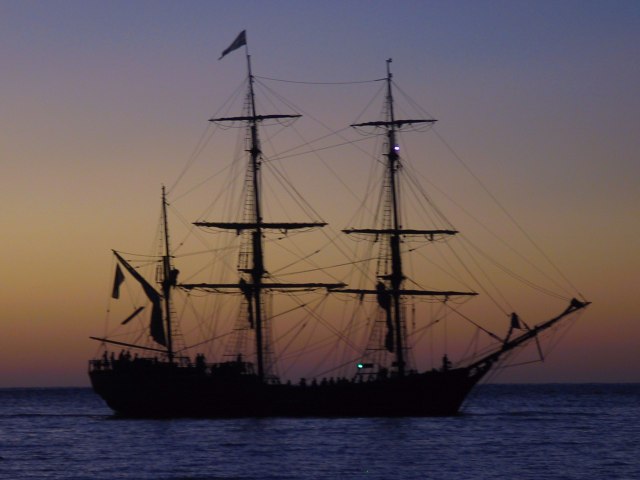 The Earl of Pembroke.
The small beaches are covered with sun-worshipers and there is even a small hotel, a couple of restaurants, one with it's own water-taxi taking people ashore or delivering take-away to the boats. We anchored, had lunch the 1st swim since entering Mar Menor on 14th July, then continued on our way, arriving at our planned destination of Cala Horts at the southern end of the SW coast of Ibiza at 07:15 next day but there was too much swell so we so we continued clockwise around the island and eventually anchored at Estancia del Dins on Isla Conejera at 09:30.
The Earl of Pembroke.
The small beaches are covered with sun-worshipers and there is even a small hotel, a couple of restaurants, one with it's own water-taxi taking people ashore or delivering take-away to the boats. We anchored, had lunch the 1st swim since entering Mar Menor on 14th July, then continued on our way, arriving at our planned destination of Cala Horts at the southern end of the SW coast of Ibiza at 07:15 next day but there was too much swell so we so we continued clockwise around the island and eventually anchored at Estancia del Dins on Isla Conejera at 09:30.
Isla Conejera is a kidney shaped island approximately 1800m by 600m and situated some 5 miles due west of San Antonio. The anchorage is deep with low rocky shores covered with scrub and pines – very green. There is also a lighthouse and tiny landing stage. We were informed by the ranger who arrived by RIB that the island was a nature reserve and going ashore was not permitted. We stayed two nights before a change in the wind prompted us to seek better shelter so we ended up in San Antonio again where we stayed for four nights apart from a small recce on the 2nd day when we discovered that although the wind was from the NE there was a heavy swell from the West! We made use of the time by frequenting the self service laundry and provisioning. Tan went to Santa Eulalia on the bus and had an enjoyable day. While she was away I managed to get a slot on the water quay (you have to book in advance by VHF in August) and replenished our water tanks.
Tan likes Santa Eulalia so we decided to head southwards down the west coast then round the corner across the south coast and onto the east coast passing between Ibiza and the island of Formentera. We duly arrived at Cala Blanco on the 12th August where I anchored, then re-anchored a few metres away after a heated exchange because the admiral didn't like our original position. We stayed two nights, there were only four boats at anchor overnight which is very unusual for the height of the season. We covered the 19nm to Santa Eulalia in just three and a half hours and anchored behind the entrance to the marina and went ashore. Santa Eulalia is a pleasant resort with many restaurants, shops to suit all pockets and some classy food stores. The promenade is beautifully landscaped and the town has a nice feel to it. Swell from boats coming and going from the harbour caused us to yaw and made it uncomfortable so after our trip ashore we re-anchored further round the bay off a lovely wooded shore with sandy beaches and two hotels, one of which was noisy so we only stayed one night.
Mallorca
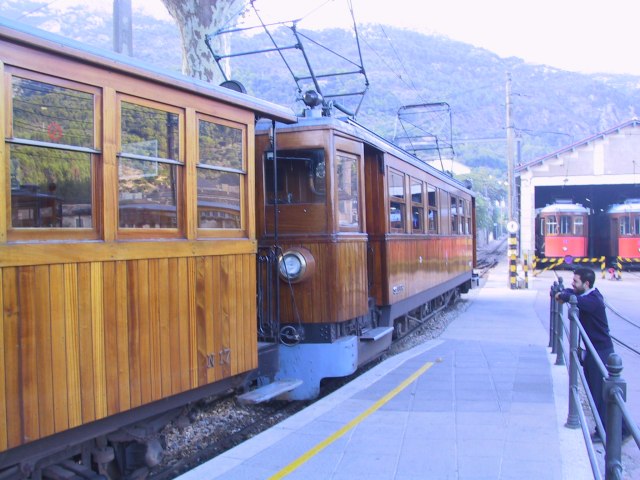 Soller to Palma narrow gauge railway
We did the crossing back to Mallorca as a day sail, leaving before sunrise at 05:55 on the 15th August and arriving at San Telmo at 15:10 where we stayed for four nights. The village of San Telmo is a charming summer resort and the anchorage popular with charter boats and locals. The water is clear and there are panoramic views of Isla Dragonera so it was quite busy with boats coming and going. There is a good bread shop in town and we had an excellent menu-del-dia at the Hostal Dragonera overlooking the bay. While we were eating the fire fighting planes were passing overhead tacking a hill fire behind the town. During our stay Tan went shopping by bus to Andraitx and regretted it because she had to stand all the way and was thrown about due to the winding mountain roads.
Soller to Palma narrow gauge railway
We did the crossing back to Mallorca as a day sail, leaving before sunrise at 05:55 on the 15th August and arriving at San Telmo at 15:10 where we stayed for four nights. The village of San Telmo is a charming summer resort and the anchorage popular with charter boats and locals. The water is clear and there are panoramic views of Isla Dragonera so it was quite busy with boats coming and going. There is a good bread shop in town and we had an excellent menu-del-dia at the Hostal Dragonera overlooking the bay. While we were eating the fire fighting planes were passing overhead tacking a hill fire behind the town. During our stay Tan went shopping by bus to Andraitx and regretted it because she had to stand all the way and was thrown about due to the winding mountain roads.
We opted to work our way anti-clockwise around Mallorca so our next port of call was Andraitx where we took on fresh water and topped up with fuel, then went alongside the town quay for a couple of hours while Tan did some shopping. Just after 3 o'clock we departed for Cala Blanco but after being at anchor for a couple of hours we decided to move because the yawing was uncomfortable. We finally settled at Camp de Mar where we stayed for 2 nights. It is a large cala with a backdrop of mountains and wooded hillsides. There are two large hotels on the beach and a couple of small shops. There is a small island connected to the shore by a wooden bridge and dominated by a restaurant, The water is clear and the swimming good and although busy during the day it is quiet at night – no loud disc music.
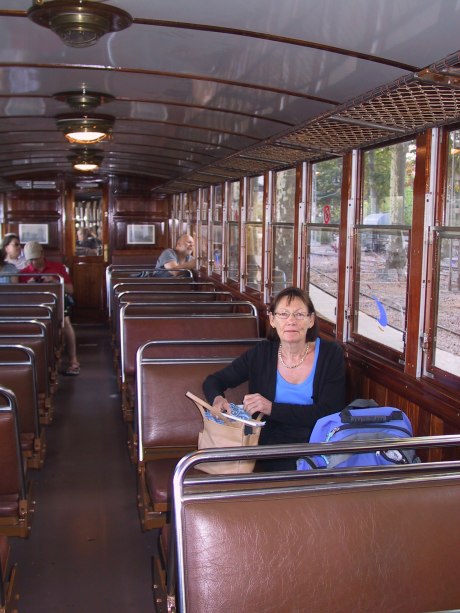 Classic on a classic
We looked at Cala Fornells and Cala Peguera while on our way to Santa Ponsa, they are both nice quiet small cala's but exposed to the predicted easterly winds so we anchored at Santa Ponsa where we stayed for 4 nights but made two separate day excursions to Cala Peguera where there is a large Mercadona supermarket and some very nice up-market shops in town where Tan bought a new handbag. After each excursion we returned to Santa Ponsa to anchor for the night. While there a nearby boat got it’s anchor rope tangled around it's neighbours rudder resulting in them coming into contact. There was no-one on board either boat so I used our dinghy to separate them to prevent any damage.
Classic on a classic
We looked at Cala Fornells and Cala Peguera while on our way to Santa Ponsa, they are both nice quiet small cala's but exposed to the predicted easterly winds so we anchored at Santa Ponsa where we stayed for 4 nights but made two separate day excursions to Cala Peguera where there is a large Mercadona supermarket and some very nice up-market shops in town where Tan bought a new handbag. After each excursion we returned to Santa Ponsa to anchor for the night. While there a nearby boat got it’s anchor rope tangled around it's neighbours rudder resulting in them coming into contact. There was no-one on board either boat so I used our dinghy to separate them to prevent any damage.
We topped up with fuel and water again before leaving Santa Ponsa on the 25th August and going to Las Illetas in the bay of Palma where we had a particularly bad night with the yawing so weighed anchor at 06:58 and were on our way to Porto Petro on the east coast covering the 42nm in seven hours. It was a rough ride until we rounded Punta Salinas onto the East coast, then we had a fresh wind behind us and made good time. However, Tan wasn't happy with the comfort here so we weighed anchor again and zipped up the coast to Porto Colom at an average speed of 7.5 knots. We had five comfortable nights at anchor in Porto Colom protected from the swell created by the force 5 north-easterly wind.
On the last day of August we left the calm of Porto Colom and headed up the coast again but due to a moderate residual swell it was obvious that anchoring on the east coast was out of the question so our passage took us onto the NW coast and into the bay of Alcudia where we dropped anchor at Cala es Calo after covering the 36nm in just over six hours. Cala es Calo is on the extreme NE tip of the large bay of Alcudia and is a popular day anchorage for local boats being both attractive and remote and well sheltered from the north east but exposed to every other direction. There is a broken-down quay and a couple of roofless crofters cottages and well used walking path.
Next day we topped up with fuel and water again at Alcudia before anchoring at Aucanada for two nights after which we went to Pollenca where we met up with Mike and Christine (Shabonee) for a menu-del-dia. There was a fire behind the port which was dealt with by the local fire brigade supported by the small fire-fighting planes and a helicopter. After six days we decided to along the north coast to Soller, anchoring at Cala Sant Vincente where we had lunch at Pepe's and watched a very nice wedding on the small moll at sunset, where we had front row seats.
At Soller I anchored fore and aft, using a stern anchor to keep us pointing towards the entrance, minimising yaw and maximising the comfort level. The Cornwall-based replica galleon Earl of Pembroke is here for the filming of the 150 million dollar blockbuster Cloud Atlas starring Halle Berry, Tom Hanks, Jim Broadbent and Hugh Grant. Built in Sweden in 1948, the 44 metre Earl of Pembroke was originally named Orion and traded timber in the Baltic sea and on the British east coast. In 1974 she was laid-up in Denmark before being bought by her current owner in 1979. At that time the Earl of Pembroke underwent a complete restoration programme lasting six years, converting her to the magnificent galleon she is today. For a couple of days the Earl of Pembroke was dwarfed by the 1905 built 57 metre 3 masted barque now being used as a cruise ship.
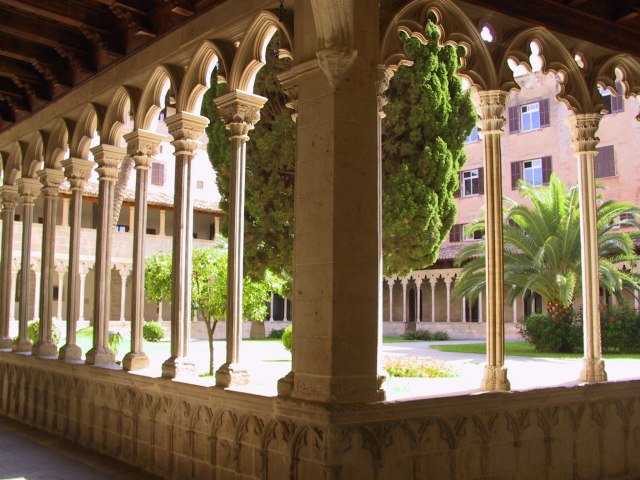 Cloister at the Basilica of St Francis, Palma
While at anchor in Soller I took the bus to Palma in search of spare parts for the boat but was unsuccessful and on the 20th Tan and I took the train from Soller through the mountains to Palma. The narrow-gauge railway established in 1912 winds 27 km through beautiful mountain scenery. As Palma expanded it had to do so around the railway track, consequently the rails run down the streets of the suburbs into the heart of the city. We had a pleasant day sightseeing and shopping in Palma where we had a very good menu-del-dia in a traditional restaurant much frequented by locals. The only downside to our stay ay Soller was when a small local boat dislodged my stern anchor late in the afternoon when there was a 2 metre swell. I tried 3 times to reset it but failed so we had a very uncomfortable night. Next day I was able to set the stern anchor again.
Cloister at the Basilica of St Francis, Palma
While at anchor in Soller I took the bus to Palma in search of spare parts for the boat but was unsuccessful and on the 20th Tan and I took the train from Soller through the mountains to Palma. The narrow-gauge railway established in 1912 winds 27 km through beautiful mountain scenery. As Palma expanded it had to do so around the railway track, consequently the rails run down the streets of the suburbs into the heart of the city. We had a pleasant day sightseeing and shopping in Palma where we had a very good menu-del-dia in a traditional restaurant much frequented by locals. The only downside to our stay ay Soller was when a small local boat dislodged my stern anchor late in the afternoon when there was a 2 metre swell. I tried 3 times to reset it but failed so we had a very uncomfortable night. Next day I was able to set the stern anchor again.
On the 25th September we want back to Pollenca because Tan was scheduled to go to Palma for a few days to look after her grandchildren while their parents were at a company event. She stayed at a four star hotel and had a chauffer driven Mercedes collect her up and bring her back. She could get used to it! Due to the forecast of some extreme weather we decided to spend a few days on the public quay now that it's low season rates. As we were entering the port the engine alarm went off – it was the alternator. The good news is that it was the brushes and I managed to get a replacement regulator/brush set at the chandlers, the bad news was that it was defective which I didn't find out until after I'd installed it, the good news was that I got a refund and after carefully cleaning the commutator rings the old brush set worked. I also had the engine water pump bearings replaced at the same time.
I had an email from an old and dear friend from my California days that she was doing a tour of Spain and Portugal and would it be possible to meet. After reviewing her itinerary we decided to meet in Madrid on the 22nd November. Consequently we decided to go back to Barcelona earlier than usual. On the 12th November we said our goodbyes to the islands and departed for Barcelona. It was an uneventful trip, the best kind, we motored and motor-sailed all the was and the alternator behaved itself although I had a contingency plan in case it failed. As is usually the case, my watch was boring no other ships in sight and also as usual Tan got all the excitement, on her watch four ships were converging on us but all passed at a safe distance. We arrived at Barcelona Port Vell at 08:25 next morning.
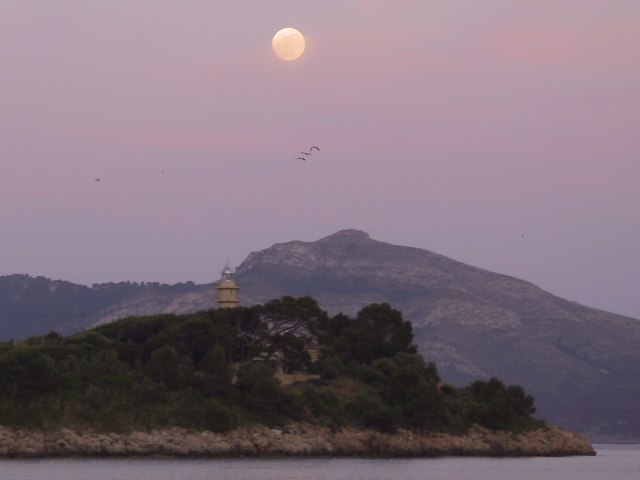 Full moon over Pollenca bay
Full moon over Pollenca bay